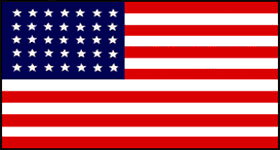 |
Civil War Battles |
|
State War Records |
| AL - AK - AZ - AR - CA - CO - CT - DE - FL - GA - HI - ID - IL - IN - IA - KS - KY - LA - MA - MD - ME - MI - MN - MS - MO - MT - NE - NV - NH - NJ - NM - NY - NC - ND - OH - OK - OR - PA - RI - SC - SD - TN - TX - UT - VT - VA - WA - WV - WI - WY |
The Battle of Fayetteville
April 18, 1863 in Fayetteville, Arkansas
 |
|||||||||||||||||||||
|
On April 16, Brig. Gen. William "Old Tige" Cabell led 900 Confederate cavalry north from Ozark to attack Union forces occupying Fayetteville. He led his troops into a fight that was a microcosm of the whole war. The 1st Arkansas Cavalry (Confederate) would battle the 1st Arkansas Cavalry (Union) in an area both called home. Two of Arkansas's most aggressive cavalry commanders attempted to reverse the Confederacy's sagging fortunes.
The first "casualties" of the battle of Fayetteville were Lt. Gustavus F. Hottenhaur and 8 of his men from Company B of the 1st Arkansas Cavalry (Union), who were enjoying a dance at a private home in West Fork some 8 miles south of the town. A detachment of Cabell's cavalry under Lt. Jim Ferguson surprised the merrymakers and demanded their surrender. The shocked Federals scattered in every direction but in the end, all 9 men were taken prisoner.
On April 18, Cabell's force arrived at Fayetteville shortly after sunrise. They approached the city from the east and advanced on the Union headquarters of commander Col. M. LaRue Harrison, just northeast of the town square.
Cabell placed his 2 pieces of artillery on a hillside east of town and opened fire on the Union camp. For almost 4 hours, the battle raged around the Union headquarters. The Confederates managed to gain control of a large house and a grove of trees south of the Union headquarters, but could go no farther.
Around 9:00 A.M., Col. J. C. Monroe led a desperate cavalry charge against the Union right, only to run into an intense crossfire in front of the Union ordnance office. Harrison had sought protection behind a tree and witnessed the Rebel charge. He later wrote, "I looked with wonder, as well as admiration, upon that splendid body of horsemen as they swept down Dixon Street.... [W]hen nearing College Avenue, they were met by a fire from the Federal soldiers the most heroic could not face it.... I stood by the tree as the cavalrymen came thundering down the road, many falling from their mounts, one horse (evidently wounded to its death) turned and with a terrific leap cleared the high plank fence and fell dead in the Baxter lot, carrying his rider with him, who, though evidently wounded, freed himself from the dead horse and made his way around the house."
Monroe's charge was the Confederate high water mark. Gradually, the Union forces began to drive back both flanks of the Confederate line. The Confederates in the Baxter house at the center of the Confederates position continued to resist for almost an hour after both wings had begun to give way, but eventually they too were driven out. By late morning, what remained of Cabell's command was retreating toward Ozark. Harrison had too few horses to mount a pursuit.
Cabell reported that he could have burned a large part of the town, "but every house was filled with women and children, a great number of whom were the families of officers and soldiers in our service." He placed part of the blame for his setback on the superior weapons possessed by the Union troops. Many of his men were armed with inferior rifles. The Federals were equipped with the longer-range Springfields and Whitneys. Despite his failure to take the town, Cabell reported that his men were "in fine spirits, and ready to try to take the enemy again and that he would shortly be prepared "to strike a heavier blow."
